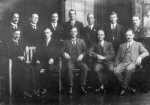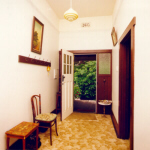A place in the sun
In 1919, a year after the Curtins moved to Cottesloe, John Curtin expended all his mental and physical energy fighting an election which he lost. His bruising experience left him needing months of recuperation.
The sun, surf and fresh air, all alleged healthy aspects of the suburb, as well as the easy availability of cricket in the summer and football in the winter, no doubt appealed to him and assisted him to regain his full strength.
|

A relaxed John Curtin at the beach
|
|
A growing family
During this period John Curtin and his wife and daughter shared their home with Elsie's parents, Abraham and Annie Needham who had travelled to Western Australia from Tasmania in 1919.
In 1923, now having two children (son John was born in 1921), the Curtins decided to buy land and build a little further south. Jarrad Street today links the beach with the railway line, but in the 1920s it stopped at the edge of Cottesloe Golf Club (now Seaview Golf Club). Families, who, like the Curtins, lived on the lower eastern slopes, could stroll across the links to reach the sea, but it was closer to the railway line than the sea - no bad thing for a man who never owned a car, but worked in the city.
|

Son John playing cricket in the backyard of the Curtin's Jarrad St home

While working as editor of the
Westralian Worker, John Curtin served as President of the AJA between 1920 and 1925.
|
|
The home itself: outside and within
Empty lots to the west and on the southern side of the Curtin's house were slowly built upon until in the late 1930s the street houses were renumbered, the Curtin address changing from 14 to 24 Jarrad Street.

|

The view from the back door of the Jarrad St home in 1927
|
|
The house was constructed by Arnold Bullock, a local builder, who was to be fruitfully employed between the wars as the suburb expanded. He built them a four-roomed brick bungalow, skirted by a timber verandah on three sides, where family memory suggests John Curtin planned to pace as he composed his speeches or editorials.
View the exterior of the home and the front and back gardens in this 1998 video footage.
Presumably because of the shape of the block, or perhaps to avoid the prevailing westerly winds, the front door was located at the eastern side of the house. It led into a long l-shaped hallway from which two bedrooms, a lounge and a kitchen opened.
|

The Jarrad St house c.1927
|
|
A water closet stood by the back fence, next to the wood-pile which a fuel stove, a fireplace and probably a chip heater in the bathroom, made obligatory. A weather-board laundry was constructed near the back door. Here stood a copper and a sink for the wearying task of the weekly wash.
Although the Curtins did not keep up with every modern development, John Curtin did not even use a safety razor, it is thought that a bathroom on the back verandah had been completed before the family moved in, otherwise they might have bathed in the laundry.
|

View of the back of the house in 1998
|
|
Inside the house there was little decoration - a few ceiling roses, no cornices, plain skirting boards and picture rail and dark stained doors.
The bedrooms had no built-in wardrobes (an innovation yet to arrive in Perth for most people), but two cupboards were supplied in the hallway and one in the room designed to be the kitchen.
Carpets covered the floors and curtains hung at the windows. It is possible that the family budget did not run to any greater detail, but it is also likely that this sparseness reveals something of the Curtins' distaste for display.
The only exception to this general theme of careful spending was Elsie's piano, which she later bought in Perth, but which is no longer in the house.
Out the back, the yard boasted a vegetable patch and lemon tree, and allowed enough space for father and growing son to conduct games of cricket.
Elsie tended both house and garden.

|

Ceiling rose in main bedroom

Entry hall showing plain dark woodwork

Mrs Curtin in the living room of the home
|
|
In 1924 John Curtin left his new home and proceeded to Geneva as one of three Australian delegates to the International Labour Organisation Conference.
While he was thoroughly preoccupied as part of an under-resourced delegation at a significant international event, his mother-in-law moved into the Jarrad Street house.
Annie Needham had been widowed in 1921. She brought with her several books, a welcome addition to Curtin's library, bookshelves and a collection of paintings which her husband had completed. For many years these were to be the only artworks displayed in the home.

|

A comfortable chair and plenty of books in the library of the Jarrad St home

One of the art works painted by Curtin's father in law
|
|

|

